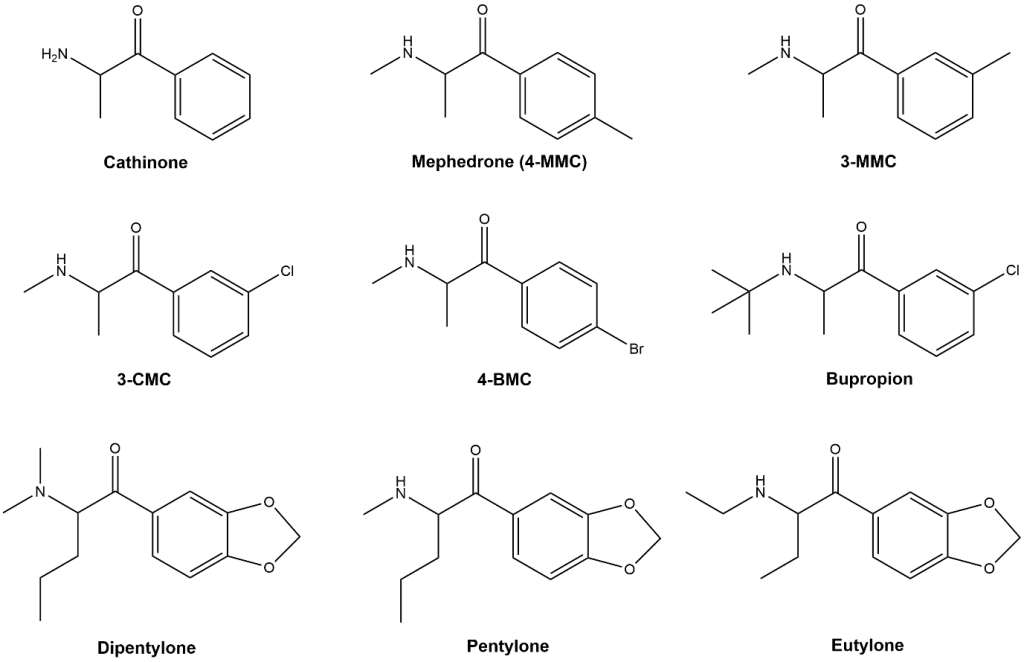
Safer Using – Psilocybin
About Psilocybin Psilocybin is a psychedelic drug with similar effects to LSD, but with a shorter duration (4-6 hours).1 Psilocybin…
Cathinone is a stimulant drug found in the leaves of khat (Catha edulis) which are chewed in Africa and the Middle East for their stimulant effects.1 More broadly, substituted cathinones (or simply cathinones) are a class of psychoactive drugs related to cathinone.1 Synthetic cathinones are commonly referred to as “bath salts” since they have been sold as powders disguised as bath salts to evade detection.1 Cathinones are a diverse group of drugs in terms of chemical structures, effects, and toxicity. Most cathinones are stimulants and empathogens (meaning they promote emotional communication and connectedness like MDMA), although some act as atypical antidepressants with little to no stimulant or empathogenic effects, such as bupropion (Zyban/Wellbutrin).1,2

The most widely known cathinone is mephedrone (also known as 4-methylmethcathinone, 4-MMC, drone, M-CAT, or meow), which is a stimulant and empathogenic drug with effects similar to MDMA (see below for an overview of the effects).3 Other sought-after cathinones include methylone, MDPV (which has effects more like cocaine), and 3-MMC (which has effects more like amphetamines).1,4 There are many new synthetic cathinones appearing in the drug market, many of which are falsely sold as other drugs, such as MDMA or mephedrone.1 These novel psychoactive substances (NPSs) are commonly referred to as research chemicals (RCs) or designer drugs. The subjective effects, dosages, and toxicity of these novel cathinones have not been researched or widely reported by users.
Across Australia, New Zealand, and the US, novel cathinones, such as dipentylone, eutylone and pentylone, are becoming more prevalent and are widely sold as other drugs.5,6,7 Dipentylone (a.k.a. N,N-dimethylpentylone or dimethylpentylone) has been detected numerous times in crystal and capsule samples expected to be MDMA at CanTEST.5 As of April 2023, 13% of the 227 samples tested at CanTEST which were expected to be MDMA contained other substances, including dipentylone.5 Dipentylone is a stimulant cathinone which may have a high tendency to cause anxiety and insomnia, but not much else is known about it.8 Other new cathinones such as 3-CMC (a.k.a. 3-chloromethcathinone or clophedrone) and 4-CMC (a.k.a. 4-chloromethcathinone or clephedrone), have been detected at CanTEST and in Europe and which were falsely sold as 4-MMC, amphetamine, and MDMA.9,10,11 If you believe your MDMA or cathinone is adulterated with another drug, test it before taking it by using reagent test kits at home (e.g., https://dancesafe.org/product/mdma-testing-kit/) or by taking it to a drug checking site.
As stimulants, cathinones have the potential to increase heart rate, blood pressure, and generally put strain on the heart.3 Hence, there are serious risks associated with taking cathinones if you have a heart condition, high blood pressure, or a history of stroke or heart attack.
Cathinones are a broad class of drugs and small differences in chemical structure can lead to large differences in subjective effects, dosage, and toxicity. Additionally, the effects of many novel cathinones have not been well documented.
Cathinones are sometimes categorised according to the other drugs they are similar to.1 For example:1,4
However, it’s important to note that these cathinones certainly have different effects, duration of effects, dosage and toxicity compared to MDMA, methamphetamine and cocaine. Newer cathinones, such as dipentylone, pentylone, and eutylone, are less well documented and harder to classify, but are known to have stimulant effects.7 Additionally, some cathinones such as bupropion (Zyban/Wellbutrin), and possibly 3-BMC and 4-BMC (brephedrone), act as atypical antidepressants rather than stimulants.2,12
The effects of mephedrone, an “MDMA-like cathinone”, can include:3
The effects of mephedrone typically last 2-5 hours when ingested orally, or 1-3 hours when snorted.3 The duration of effects varies between cathinones, and some may last longer than mephedrone. For example, 3-MMC can last 4-7 hours when snorted or taken orally, and pentylone can last 3-4 hours when snorted or taken orally.13,14
The dosage varies between cathinones, with some being significantly more potent than others. Dosages can also vary between individuals, so it’s important to start at a low dose and wait before redosing cathinones (start low and go slow). The dosages for two cathinones are listed below.
The following is a rough dosage guide for oral mephedrone (4-MMC):3
LOW DOSE – 50-100 mg
MEDIUM DOSE – 100-200 mg
STRONG DOSE – 150-300 mg
HEAVY, POSSIBLE OVERDOSE – 300+ mg
The following is a rough dosage guide for snorted mephedrone (4-MMC):3
LOW DOSE – 15-25 mg
MEDIUM DOSE – 20-80 mg
STRONG DOSE – 75-125 mg
HEAVY, POSSIBLE OVERDOSE – 125+ mg
The following is a rough dosage guide for oral pentylone:14
LOW DOSE – 10-20 mg
MEDIUM DOSE – 20-40 mg
STRONG DOSE – 40-80 mg
Pentylone is significantly more potent than mephedrone, and may be even more potent when snorted.3,14 Dipentylone may be as potent or even more potent than pentylone. People who take dipentylone or pentylone thinking it is MDMA, and therefore take the average dose of MDMA (75-125 mg), may be at a greatly increased risk of overdose.14,15 It is therefore important to test it before you take it and to accurately weigh out your doses.
The effects of an overdose on cathinones are generally similar to other stimulants. The line between a recreational dose of cathinones and a dangerous dose of cathinones is blurry and individual differences play a large part.16 The risk of overdose and death greatly increases when cathinones are mixed with other drugs, especially other stimulants.16 Mixing stimulants with depressants, such as alcohol or opioids, can diminish the effects and cause you to take more of either substance, increasing the risk of overdose.
The effects of an overdose on cathinones can include:11,17
Additionally, “MDMA-like cathinones” including mephedrone may cause serotonin syndrome when taken at high doses or combined with other drugs that increase serotonin, including MDMA, monoamine oxidase inhibitors (a type of antidepressant), tramadol, dextromethorphan (DXM) and possibly some supplements (e.g., 5-HTP).3,18 For more information on serotonin syndrome, please visit: https://www.cahma.org.au/article/safer-using-mdma/.
If you believe someone has overdosed on a cathinone, consider seeking medical attention and wait with them until they recover.
The unique dangers of overdosing novel cathinones, such as dipentylone, are mostly unknown. Dipentylone has been associated with multiple deaths in the US, most of which were due to toxicity from ingesting dipentylone alongside other drugs as well as co-occurring medical conditions such as obesity.19 Persisting insomnia may be a unique effect of dipentylone overdose.8
[1] https://doi.org/10.2174/1570159X13666141210224137
[2] https://doi.org/10.1586/14737175.6.9.1249
[3] https://wiki.tripsit.me/wiki/Mephedrone
[4] https://doi.org/10.1016%2Fj.neuropharm.2017.07.026
[5] https://health.act.gov.au/sites/default/files/2023-07/CanTEST%20Final%20Evaluation%20Report_2023.pdf
[9] https://twitter.com/CanTESTCBR/status/1605334993370480640
[10] https://twitter.com/CanTESTCBR/status/1615194977063276544
[12] https://doi.org/10.1002/ddr.10297
[13] https://drugs.tripsit.me/3-mmc
[14] https://drugs.tripsit.me/pentylone
[15] https://drugs.tripsit.me/mdma
[16] https://www.europeanreview.org/article/9615
[17] https://litfl.com/sympathomimetic-toxidrome/
[18] https://doi.org/10.1056/NEJMra041867
[19] https://doi.org/10.1093/jat/bkad037
Written by Darcy Lynch

About Psilocybin Psilocybin is a psychedelic drug with similar effects to LSD, but with a shorter duration (4-6 hours).1 Psilocybin…

About Heroin Heroin (AKA diacetylmorphine or diamorphine) is a depressant drug belonging to the semi-synthetic opioid class.1 It goes…

About LSD LSD or lysergic acid diethylamide (also known as acid or LSD-25) is a potent psychedelic drug, infamous for…